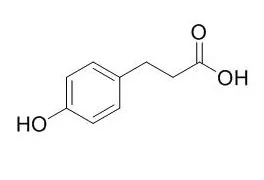| In vitro: |
| Food Microbiol. 2015 May;47:36-44. | | Application of Lactobacillus amylovorus DSM19280 in gluten-free sourdough bread to improve the microbial shelf life.[Pubmed: 25583336 ] |
METHODS AND RESULTS:
The present study investigated the antifungal activity of Lactobacillus amylovorus DSM19280 as a starter culture for gluten-free quinoa sourdough bread under pilot-plant conditions to extend the microbial shelf life. Challenge tests against environmental moulds were conducted and a negative control with non-antifungal strain, L. amylovorus DSM20531(T), as well as a chemically acidified and a non-acidified control were included. Organic acid production, antifungal metabolites, carbohydrates changes during fermentation and bread quality were compared to wheat counterparts. The application of quinoa sourdough fermented with the antifungal L. amylovorus DSM19280 extended the mould free shelf life by 4 days compared to the non-acidified control. No significant difference in lactic acid production was found between the lactobacilli strains. HPLC-UV/DAD was used to quantify antifungal compounds. The concentration of 4-hydroxyphenyllactic acid, Phloretic acid, 3-phenyllactic acid and hydroferulic acid were significantly higher (P < 0.01) in the quinoa sourdough fermented with the antifungal L. amylovorus DSM19280 when compared to the non-antifungal strain, thus indicating their contribution to the antifungal activity. Evaluation of bread characteristics such as specific volume or crumb hardness, revealed that the addition of L. amylovorus fermented sourdough also improved bread quality.
CONCLUSIONS:
In conclusion, the combination of quinoa flour fermented with the antifungal L. amylovorus DSM19280 serves a great potential biopreservative ingredient to produce gluten-free breads with an improved nutritional value, better bread quality and higher safety due to an extended shelf life, and therefore meeting consumer needs for good quality and preservatives-free food products. | | Anticancer Res. 2014 Nov;34(11):6573-9. | | Cytotoxic and anti-metastatic activities of phenolic compounds from Dendrobium ellipsophyllum.[Pubmed: 25368260] |
Phenolic compounds isolated from Dendrobium ellipsophyllum Tang & Wang (Orchidaceae) have been shown to possess potential pharmacological activity; however, their anticancer as well as anti-metastasis activities are largely unknown. The aim of the present study was to isolate active compounds from D. ellipsophyllum and to explore the possible effects of phenolic compounds isolated from the plant for cytotoxic as well as anti-metastatic properties.
METHODS AND RESULTS:
The compounds were isolated by using chromatographic techniques including silica gel and Sephadex LH20. Each of the isolates was evaluated for their cytotoxicity on H292 human lung cancer cell lines by 2,3-Bis(2-methoxy-4-nitro-5-sulfophenyl)-2H-tetrazolium-5-carboxanilide assay. The cytotoxic compounds were further evaluated for apoptosis-inducing and anoikis-sensitizing effects.
Ten phenolic compounds were isolated, 5,7-dihydroxy-chromen-4-one (1:); 4,5-dihydroxy-2,3-dimethoxy-9,10-dihydrophenanthrene (2:); moscatilin (3:), 4,4'-dihydroxy-3,5-dimethoxybibenzyl (4:); 4,5,4'-trihydroxy-3,3'-dimethoxybibenzyl (5:); (2S)-homoeriodictyol (6:); (2S)-eriodictyol (7:); chrysoeriol (8:); Phloretic acid (9:); and luteolin (10:). Compounds 4:, 5:, 8: and 10: exhibited appreciable cytotoxic activity with 50% inhibitory concentration values less than 250 μM. These compounds also showed potential apoptosis induction and anoikis-sensitizing effect at non-toxic concentrations.
CONCLUSIONS:
Compounds 4:, 5:, 8: and 10: are responsible for cytotoxic and anti-metastatic activities of D. ellipsophyllum. |
|






 Cell. 2018 Jan 11;172(1-2):249-261.e12. doi: 10.1016/j.cell.2017.12.019.IF=36.216(2019)
Cell. 2018 Jan 11;172(1-2):249-261.e12. doi: 10.1016/j.cell.2017.12.019.IF=36.216(2019) Cell Metab. 2020 Mar 3;31(3):534-548.e5. doi: 10.1016/j.cmet.2020.01.002.IF=22.415(2019)
Cell Metab. 2020 Mar 3;31(3):534-548.e5. doi: 10.1016/j.cmet.2020.01.002.IF=22.415(2019) Mol Cell. 2017 Nov 16;68(4):673-685.e6. doi: 10.1016/j.molcel.2017.10.022.IF=14.548(2019)
Mol Cell. 2017 Nov 16;68(4):673-685.e6. doi: 10.1016/j.molcel.2017.10.022.IF=14.548(2019)